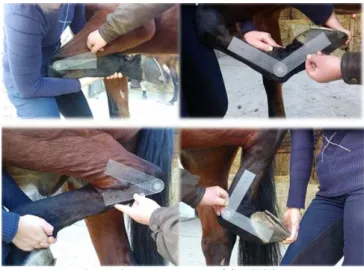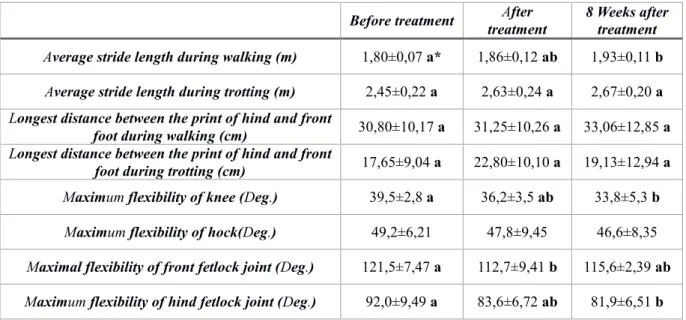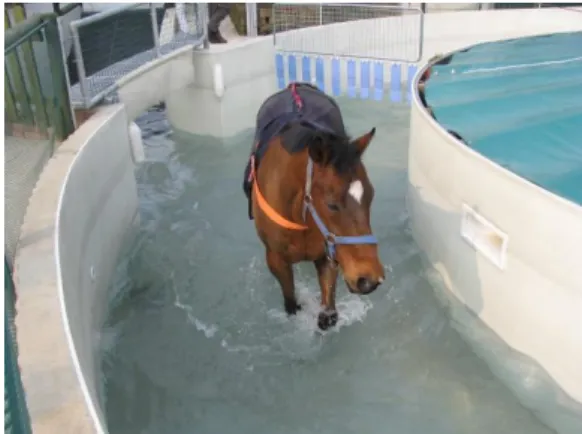ISSN 2416-2140 of the European Ecocycles Society
Ecocycles, Vol. 5, No. 2, pp. 19-23 (2019) DOI: 10.19040/ecocycles.v5i2.139
CASE STUDY
Veterinary use of thermal water and mud from Lake Hévíz for equestrian injury prevention and rehabilitation
Bartos, A.
1, Bányai, A.
1, Koltay, I.
1, Ujj, Zs.
1, Such, N.
1, Mándó, Zs.
2, Novinszky P.
31Georgikon Faculty, University of Pannonia, 8360 Keszthely, Hungary; 2Saint Andrew Hospital for Rheumatic Diseases, Hévíz, Hungary; 3University of Veterinary Medicine, Budapest, Hungary
Corresponding author: Ádám Bartos, Ph.D. tel.: +36-30-9739-295 bartos-a@georgikon.hu
Abstract – Beneficial effects of thermal mud treatment in the human medical field have been known for many years. However, such treatments have never been studied and used in veterinary science. The aim of our study was to investigate how a mud treatment from Héviz Spa Lake affects the movement quality and flexibility of certain joints in horses. Wet sludge was applied on the knee, hock, elbow, shoulder, back, stifle, front and hind cannons and fetlock joints for a period of eight weeks. Our results show, that the mud treatment from Lake Héviz may have beneficial effects on the joints, and play an important role in the locomotion therapy of horses.
Keywords – thermal mud, Lake Héviz, veterinary use, horse movement quality, flexibility of joints Received: July 30, 2019 Accepted: October 15, 2019
Lake Héviz – a geological curiosity
Lake Héviz is Europe's largest thermal lake - a warm water lake situated in a peat-bed. The 4.44 ha water-surface lake (Figure 1) is surrounded by a 60.5 ha nature conservation area. 1
Springs of different temperatures mix in a narrow cave and became a constant (38,5 °C) temperature stream when entering the lake. Beautiful water lilies, brought to Hungary at the end of the 19th century, dot the lake, supporting the eco- life, with leaves slowing down evaporation, and creepers protecting the medicinal mud on the bottom of the lake. Hévíz Thermal Lake and traditional human treatments are from the year 2015 part of National Heritage. The thermal water comes from an about 40 m deep situated cave (Bergmann, 2014).
1 A preliminary account of this work has been presented at the conference “Developmental potentials in terms of nutrition, exercise and health” held in Rakican, Slovenia on October 25-26, 2016.
Effect of medical mud on the joints and locomotion activities of horses
Medical research for humans provided evidence regarding the beneficial effects of thermal mud in the treatment of rheumatism (Gyarmati and Kulisch 2008).
As a result, the thermal sludge product has been developed, which is successfully applied more widely, especially in the rehabilitation of rheumatic diseases (Gyarmati et.al., 2012).
Research results related to the management of horses for the time being, however, are not available.
Materials and methods
Hévíz medical mud is a mixture of turf next to Hévíz and water from the thermal lake, which was produced in a modern
20
mud factory. This is an organic mud with dark grey color and soft texture. Main components: thermal water (72-82 %), minerals (4.5-7.7%), organic material (13.5-14.3%), sulphur (2.4%), humic acids (5%) (Bartos et al., 2015).
The aim of our study was to investigate how a mud treatment from Héviz Spa Lake affects the movement quality and flexibility of certain joints in horses. An experiment was carried out with 10 male and female school and sport horses.
All of the horses had been ridden longer period than 3 years and had a correct and healthy movement. Horses were treated with mud ten times, respectively, twice daily in the evenings.
Figure 1. Aerial view of Lake Héviz Source: https://en.wikipedia.org/wiki/Lake_Hévíz
Wet sludge was applied on the knee, hock, elbow, shoulder, back, stifle, front and hind cannons and fetlock joints (Figure 2).
Figure 2. Treated parts of the body.
The sludge used for treatments was washed off in the morning. Before the experiment, at the end of the mud treatments and 8 weeks following the average stride length and the longest distance between the print of hind and front foot during walking and trotting, maximal flexibility of knee, hock and fetlock joints were measured. To calculate the number of steps horses were led straight during walking and trotting on a 30 m long flat surface. Following this the stride length was determined. To determine the longest distance between the print of hind and front foot on flat, sandy soil, the distance between hind and front prints was measured three
times. The maximal flexibility of each joint was measured with a joint protractor (Figure 3). Statistical analysis was carried out with one-way analysis of variance (ANOVA) with SPSS 7.0 program.
Figure 3. Measurment of flexibility.
Results and discussion
According to the results (Table 1), the horses responded positively to the treatments. The most positive results were detected by the average stride length during walking, maximal flexibility of the front fetlock, knee, and hock. This is partly explicable with the beneficial effects of sulfur on the joints, which is well-known in human medicine (Kovács et.al.
2012). The stride length and longest distance between the print of hind and front foot were lower but positively influenced by the mud treatment. Eight weeks after the treatments most of the parameters, similar to human therapeutic results (Kulisch et.al. 2012), compared to those obtained directly after the mud baths, values were further improved. Although a slightly negative effect was observed only for a few test values, the results obtained here were more favorable, as at the beginning of the experiment. The results seem to confirm that the treatment has long-term effects. This can be explained by the absorption processes of sulfur from the mud and the subsequent chemical reactions, during which elemental sulfur absorbed through the skin and sulfur oxidized from the absorbed hydrogen sulfide may be another source of hydrogen sulfide formation in the body (Gyarmati,1982).
Our results show, that the mud treatment from Hévíz Spa Lake may have beneficial effects on the joints, playing research has to be carried out to confirm the results. The results of the present experiment and the prospect of further research could be pioneer, as the Héviz mud, as well as the thermal effect of water even before in the equine medicine has not been demonstrated experimentally, only individual observations are available. Thus, the veterinary use of Héviz mud, which has been proven many times in human medicine, seems to be a new research field.
The results are remarkable as well, also because of the evidence of the chemical impact of mud also can help. Such
21
modes of action are still under research and only partly demonstrated in human medicine (Odabasi et.al. 2008).
Further veterinarian research has to be carried out to confirm the results. The results of the present experiment and the prospect of further research could be pioneering, as the Héviz mud, as well as the thermal effect of water even before in the equine medicine, have not been demonstrated experiment- tally, only individual observations are available. So the veterinary use of Héviz mud, which has been proven many times in human medicine, seems to be a new research field.
The concept of a Balneotherapeutic equine medical center
The center would be situated near the lake, next to the outlet canal. Today horses can’t be treated directly in the lake because of the modern infrastructure. Interestingly, about 100 years ago an elephant from the Budapest Zoo was treated against rheumatism in Lake Heviz (Figure 4). The water quality and temperature in the outlet canal are similar to those of the water in the Lake (Tóth et al., 2015).
Main components of the planned center (Figure 5) are:
- Balneotherapeutic horse walker for four horses
- Stable with 4 boxes and 2 treating boxes with equine solarium
- Pumphouse
- Reed root water cleaning system - Solar panels – photovoltaic energy.
The covered balneotherapeutic walker (Figure 6) is the main element of the center. The most important function of the walker is medical treatment and rehabilitation. The water level in the equipment can be regulated with pumps, so this
can also be useful for training various muscle groups (Seawalker, 2013).
Treating boxes in the stable with equine solarium (Figure 7) are for drying horses after the water treatment. This solarium is also good for warming the muscles of the horses and can decrease the lactic acid production in the muscles (Pongrácz, 2007). In these boxes, we can make also supplementary mud treatments with medical mud.
Figure 4. Nelly the elephant in Lake Héviz in 1914. Source:
https://zoobudapest.com/ezt-latnod-kell/hirek/nelly-elefant- hevizi-kezelese
In the wall of 4 stable boxes, there are salt bricks (Figure 8), which function as salt cells, which can be a supplementary treatment for the respiratory system of the horse.
For the energy supply of the center, we would like to use a solar cell system (photovoltaic energy), which is environmentally friendly and economical. For removing Table 2. Effects of Hévíz thermal mud treatments on the examined parameters.
Before treatment After
treatment 8 Weeks after treatment Average stride length during walking (m) 1,80±0,07 a* 1,86±0,12 ab 1,93±0,11 b
Average stride length during trotting (m) 2,45±0,22 a 2,63±0,24 a 2,67±0,20 a Longest distance between the print of hind and front
foot during walking (cm) 30,80±10,17 a 31,25±10,26 a 33,06±12,85 a Longest distance between the print of hind and front
foot during trotting (cm) 17,65±9,04 a 22,80±10,10 a 19,13±12,94 a Maximum flexibility of knee (Deg.) 39,5±2,8 a 36,2±3,5 ab 33,8±5,3 b Maximum flexibility of hock(Deg.) 49,2±6,21 47,8±9,45 46,6±8,35 Maximal flexibility of front fetlock joint (Deg.) 121,5±7,47 a 112,7±9,41 b 115,6±2,39 ab Maximum flexibility of hind fetlock joint (Deg.) 92,0±9,49 a 83,6±6,72 ab 81,9±6,51 b
* Averages with different letters in a row differ significantly (p<0,05)
22
horse feces from the water, a special reed bed system (Figure 9), a natural wastewater purification system based on root filtration, microbial activity and physical aeration of the soils (Némethy and Molnár, 2013) shall be installed.
Reed beds are able to tackle ammonia, heavy metals, suspended solids, sewage, organic petrochemical derivatives including diesel and various solvents, phenol and phenolic compounds, pesticides and fecal coliforms, bacterial contamination, etc. This system can decrease the nitrogen and phosphorus content of the water and the eutrophication can be decreased or prevented in the outlet canal (Simándi, 2011).
Figure 5. Layout plan of the balneotherapeutic center.
Figure 6. Layout of the covered horse-walker.
Figure 7. Equine solarium with air circulation for drying the ventral part of the horse.
Conclusions
The equine medical center would have an important role in horse health, in prevention and rehabilitation, with the water level regulation it is also good for muscle and condition training of horses. This center can be used as a research center. The results of equine experiments are also very useful in human balneotherapeutic research because there is no placebo effect in horses. The system is very environment- friendly, economical and can be used without stress for horses. The center can be used all year round because the temperature of water in the canal is never below 22 °C. Very important, that this balneotherapeutic center would be absolutely unique in the world.
Figure 8. Salt bricks in the wall of a box.
References
Bartos A., Bányai A., Koltay I., Mándó Zs. (2015): Effect of mud treatment from Hévíz Spa Lake on the joints and locomotion activities of horses. Proceedings of 3rd International Equine Science Meeting. Nürtingen, 28-29.
May (ISBN 978-3-95625-000-2)
Bergmann A. (2014): Therapies in Heviz. Spring Med, Budapest
Gyarmati, J. (1982): Experiences of Heviz mud treatments.
FITEC Congress, Budapest
Gyarmati, N. and Kulisch Á. (2008): History and description of héviz spa with special emphasis on weight-bath. La Presse thermale et climatique 2008; 145:233-242.
Gyarmati N., Mándó, Zs., Bergmann, A., Mózes, M. (2012.):
The role of mud treatment int he rehabilitation of reumatic illnesses. XXXI: Conference of The Hungarian Society for Medical Rehabilitation and Physical Medicine 6-8.
September. Szombathely, Hungary
Kovács C., Pecze M., Tihanyi Á., Kovács L., Balogh S., Bender T. (2012): The effect of sulphurous water in patients with osteoarthritis of hand. Double-blind, randomized,
23
controlled follow-up study. Clinical Rheumatology 31(10):
1437-42.
DOI: 10.1007/s10067-012-2026-0
Kulisch, Á. and her medical team (2012): Survey of Heviz thermal-mineralwater on patienten suffering from primer knee-arthrosis. As medicinal declaration of human research.
Essay, Saint Andrew Hospital for Reumatic Diseases, Heviz, Hungary
Némethy and Molnár (2013): Key issues of lake management in connection with mitigation of adverse effects of climate change, agriculture, sustainable regional development, energy production and development of sustainable tourism.
Zeszyty Naukowe WSTiE, Sucha Beskidzka, Poland. ISSN:
2084-8722, 4/2013, pp. 24-54
Odabasi, E., Turan, M., Erdem, H., Tekbas, F. (2008): Does mud pack treatment have any chemical effect? A randomized
controlled clinical study. Journal of Alternative &
Complementary Medicine; Jun, Vol. 14 Issue 5, p559 DOI: 10.1089/acm.2008.0003
Pongrácz L. (2007): Horsepower (in Hungarian) Equinter, Budapest
Seawalker (2013): Revolutionary new cross training water- walker from Seawalker takes performance training to a new level… www.equinehealthcentre.com
Simándi, P. (2011): Wastewater clenaning technologies II.
(In Hungarian), Digitális Tankönyvtár www.tankonyvtar.hu Tóth, Gy. (2015): Hévíz Lake 2009-2015: Research, monitoring-development, practical water management. XXII.
Conference on under earth waters, 8-9 April, Siófok.
© 2019 by the author(s). This article is an open-access article distributed under the terms and conditions of the Creative Commons Attribution (CC-BY) license (http://creativecommons.org/licenses/by/4.0/).


